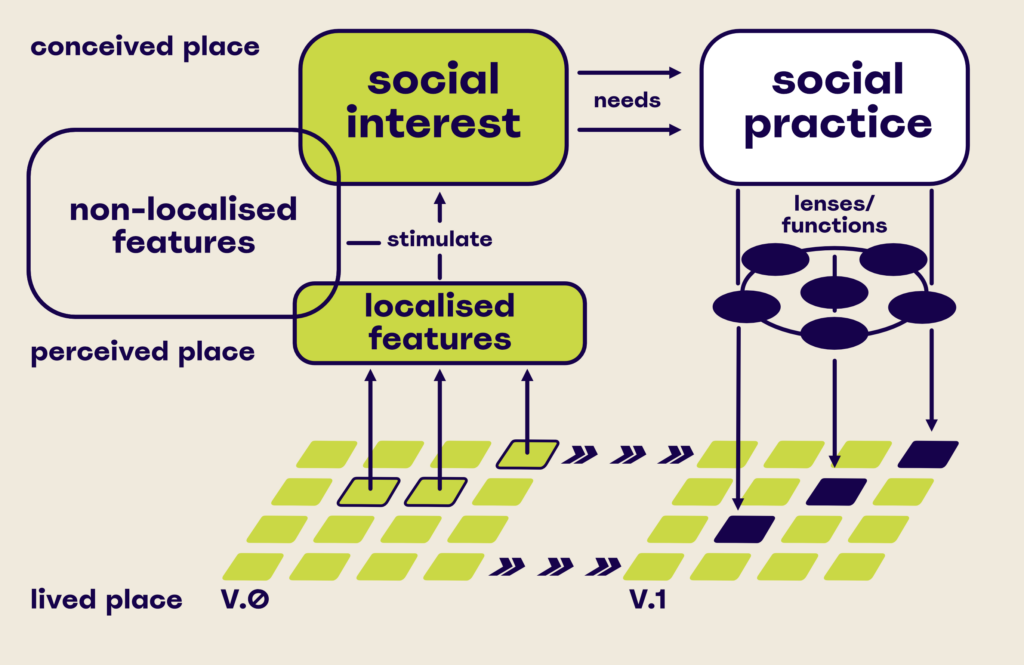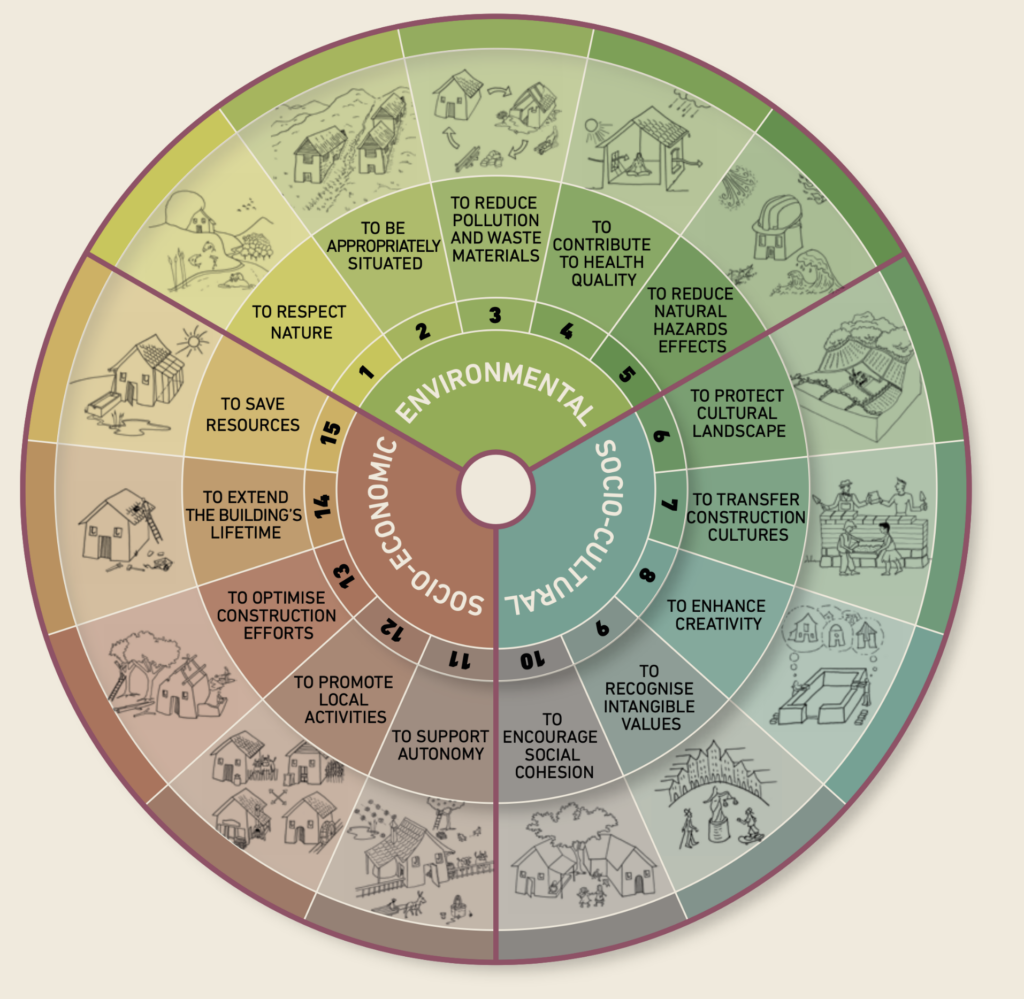Executive Summary
Today’s cities pulse to the rhythm of minutes – from “15-minute cities” to “5-minute walks”. But what if we could imagine cities where natural rhythms, contemplation, and quality of stay take precedence over efficiency?
The Nominute.City research initiative proposes a shift from efficiency-oriented to care-oriented urbanism, by reconceptualising urban space-time as a commons that serves both human wellbeing and planetary health. Building on Henri Lefebvre’s “Right to the City”, and the Space-Place-Identity framework developed by the project’s Principal Investigator Dr Jan Eckert, the research reimagines urban «oeuvre» in response to three key challenges: post-growth transformation, demographic change and climate resilience:
Post-Efficiency as an Urban Paradigm
Automation and AI challenge traditional notions of productivity and urban efficiency, while commodification and increased leisure create new pressures on shared spaces. Research explores how cities can evolve from centres of commercial exploitation to regenerative commons that balance collective wellbeing and leisure with ecological restoration, while preventing overuse of shared resources.
Multi-Generational Cities
Demographic changes due to declining birth rates and increased longevity require new urban approaches. Research explores how urban systems can support the diverse time patterns of a multi-generational population by creating environments that balance active exchange with qualities of rest and presence, enabling both extended active lifespans and attractive conditions for young families, while fostering intergenerational networks of care.
Climate Resilience
Climate change is increasing adaptation pressures on socio-urban systems, with particular impacts on vulnerable populations. Research
will explore how ecological cycles and changing climate patterns can be aligned with social behaviours to ensure climate-resilient urban systems that serve both human wellbeing and planetary health.
Contextualisation and Critical Perspective
Nominute.City positions itself within the context of contemporary placemaking, while taking a critical stance towards current developments in the built environment, as observed in the context of investment-driven real estate development or the gentrification and commercialisation of public space through proprietary smart city approaches.
At the same time, the architectural-technological renewal of urban space and its connection to digitally-enabled service models has the potential to constructively and innovatively address many of the challenges described in Nominute.City. This creates a field of tension between the technology-driven renewal of urban space and the historically evolved cultural layer, particularly visible in vernacular urban spaces.
To sharpen the research approach of Nominute.City, models emerging from this field of tension are also considered: for example, the four-dimensional Placemaking Model of the Project for Public Spaces (PPS), the New European Bauhaus (NEB) Impact Model for Climate Positive Cities, or the Vernacular Heritage Sustainable Architecture (VERSUS) assessment method. These models provide important links for developing a contemporary understanding of urban livability in the context of the temporality newly conceived in Nominute.City.
Complementing these models, which focus primarily on the material basis of the built environment, the Inner Development Goals model is applied in the context of the relationship between individual, community and place. This allows factors such as presence to be positioned as a counterpoint to efficiency, and explores how such models can contribute to looking at cities and the design of urban spaces through an alternative lens.
deutsch
In unseren heutigen Städten scheint sich alles im Minutentakt zu bewegen – von der „15-Minuten-Stadt” bis zum „5-Minuten-Spaziergang”. Was wäre, wenn Städte stattdessen natürlichen Rhythmen folgen würden? Wenn sie Momente der Kontemplation fördern und Aufenthaltsqualität wichtiger wäre als Effizienz?
Ausgehend von diesen Fragen entwickelt die Forschungsinitiative Nominute.City einen Ansatz für die Transformation urbaner Räume von einem effizienzorientierten zu einem Urbanismus, der urbane Raumzeit als Gemeingut neu definiert, das sowohl dem menschlichen Wohlbefinden als auch der Gesundheit des Planeten dient. Aufbauend auf Henri Lefebvres “Recht auf Stadt” und dem von Dr. Jan Eckert entwickelten Rahmenkonzept “Ort-Platz-Identität” untersucht Nominute.City daher die urbane Raumzeit auf drei zentrale Herausforderungen: Postwachstumstransformation, demografischer Wandel und Klimaresilienz:
Post-Effizienz als Urbanes Paradigma
Automatisierung und künstliche Intelligenz stellen traditionelle Vorstellungen von Produktivität und städtischer Effizienz in Frage, während Kommerzialisierung und mehr Freizeit neuen Anpassungsdruck auf gemeinschaftlich genutzte Räume erzeugen. Nominute.City untersucht daher, wie sich Städte von Territorien kommerzieller Ausbeutung zu regenerativen Gemeingütern entwickeln können, die kollektives Wohlbefinden und Freizeit mit ökologischer Wiederherstellung in Einklang bringen und gleichzeitig die Übernutzung gemeinsamer Ressourcen verhindern.
Mehrgenerationenstädte
Der demographische Wandel mit sinkenden Geburtenraten und steigender Lebenserwartung erfordert neue urbane Konzepte. Nominute.City untersucht, wie sozio-urbane Systeme die verschiedenen Lebensphasen einer Mehrgenerationenbevölkerung unterstützen können, indem sie Umgebungen schaffen, die aktiven Austausch mit Ruhe- und Aufenthaltsqualität verbinden und sowohl ein längeres aktives Leben als auch attraktive Bedingungen für junge Familien bieten und somit generationenübergreifende Netzwerke fördern.
Klimaresilienz
Der Klimawandel erhöht den Anpassungsdruck auf sozio-urbane Systeme mit besonderen Auswirkungen auf vulnerable Bevölkerungsgruppen. Nominute.City untersucht daher, wie ökologische Kreisläufe und sich verändernde Klimamuster mit sozialen Verhaltensweisen in Einklang gebracht werden können, um klimaresiliente sozio-urbane Systeme zu schaffen, die sowohl dem menschlichen Wohlbefinden als auch der Gesundheit des Planeten dienen.
Kontextualisierung und kritischer Standpunkt
Nominute.City verortet sich im theoretischen Kontext aktueller Ansätze und Praktiken des Placemaking. Zugleich nimmt das Projekt kritisch Stellung zu aktuellen Entwicklungen der gebauten Umwelt, wie sie im Kontext der investitionsgetriebenen Immobilienentwicklung oder der Gentrifizierung und Kommerzialisierung des öffentlichen Raums durch proprietäre Smart City-Ansätze zu beobachten sind.
Gleichzeitig hat die bautechnologische Erneuerung des Stadtraums und ihre Verknüpfung mit digital gestützten Servicemodellen das Potenzial, vielen der in Nominute.City beschriebenen Herausforderungen konstruktiv und innovativ zu begegnen. Damit eröffnet sich ein Spannungsfeld zwischen der technologiegetriebenen Erneuerung des Stadtraums und der historisch gewachsenen kulturellen Ebene, wie sie insbesondere in vernakulären urbanen Räumen sichtbar wird.
Zur Schärfung des Forschungsansatzes von Nomiute.City werden daher auch Modelle herangezogen, die aus diesem Spannungsfeld stammen: beispielsweise das vierdimensionale Placemaking Model des Project of Public Spaces PPS, das New European Bauhaus (NEB) Impact Model for Climate Positive Cities oder die Vernacular Heritage Sustainable Architecture (VERSUS) Assessment Methode. Diese Modelle bieten wichtige Anknüpfungspunkte für die Entwicklung eines zeitgenössischen Verständnisses von urbaner Aufenthaltsqualität im Kontext der in Nominute.City neu gedachten Zeitlichkeit.
Ergänzend zu diesen Modellen, die primär von der materiellen Basis der gebauten Umwelt ausgehen, wird im Kontext der Beziehung zwischen Mensch, Gemeinschaft und Ort das Modell der Inner Development Goals herangezogen. Dieses ermöglicht es, Faktoren wie Präsenz als Kontrapunkt zur Effizienz zu setzen und zu untersuchen, wie solche Modelle dazu beitragen können, die Stadt und die Gestaltung urbaner Räume aus einer alternativen Perspektive zu betrachten.
italiano
Nelle città di oggi, tutto sembra ruotare attorno all’orologio. Ci troviamo immersi in un mondo di città a “15 minuti”, passeggiate a “5 minuti”, e metriche di efficienza senza fine. Ma cosa accadrebbe se immaginassimo città in cui i ritmi naturali sostituissero degli orari prestabiliti, e la qualità della presenza e della vivibilità prevalessero sull’ossessione per l’efficienza?
Il progetto di ricerca Nominute.City affronta questa questione e propone un approccio alternativo per la comprensione e la progettazione degli spazi urbani, ridisegnando lo spazio-tempo urbano come un bene comune che contribuisce sia al benessere umano sia alla salute del pianeta. Basandosi sul “diritto alla città” di Henri Lefebvre e sul modello “Spazio-Luogo-Identità” sviluppato da Dr Jan Eckert, Nominute.City esamina quindi lo spazio-tempo urbano in termini di tre sfide centrali: trasformazione post-crescita, cambiamento demografico e resilienza climatica.
La post-efficienza come paradigma urbano
L’automazione e l’intelligenza artificiale stanno mettendo in discussione le nozioni tradizionali di produttività ed efficienza urbana, mentre la commercializzazione e l’aumento del tempo libero stanno creando nuove pressioni per adattarsi agli spazi condivisi. Nominute.City esplora quindi come le città possano evolvere da territori di sfruttamento commerciale a beni comuni rigenerativi che conciliano il benessere collettivo e il tempo libero con il ripristino ecologico, impedendo al contempo l’uso eccessivo delle risorse condivise.
Città multigenerazionali
Il cambiamento demografico, con il calo delle nascite e l’aumento dell’aspettativa di vita, richiede nuovi approcci urbani. Nominute.City studia come i sistemi socio-urbani possano supportare le diverse fasi della vita di una popolazione multigenerazionale, creando ambienti che combinano attività e riposo, offrendo condizioni attraenti per le giovani famiglie e promuovendo le reti intergenerazionali.
Resilienza climatica
Il cambiamento climatico aumenta la pressione sui sistemi socio-urbani affinché si adattino, con effetti particolari sui gruppi di popolazione più vulnerabili. Nominute.City esplora quindi il modo in cui i cicli ecologici e i modelli climatici mutevoli possano essere conciliati con i comportamenti sociali per creare sistemi socio-urbani resilienti al clima e al servizio del benessere umano e della salute del pianeta.
Contestualizzazione e punto di vista critico
Nominute.City si colloca nel contesto teorico degli approcci e delle pratiche attuali del placemaking. Allo stesso tempo, il progetto assume una posizione critica rispetto agli sviluppi attuali dell’ambiente costruito, come si osserva nel contesto dello sviluppo immobiliare guidato dagli investimenti o della gentrificazione e commercializzazione privata dello spazio pubblico attraverso approcci come Smart City.
Al contempo, il rinnovamento tecnologico dell’edilizia e la sua connessione con modelli di servizio supportati digitalmente ha il potenziale per affrontare costruttivamente e innovativamente molte delle sfide descritte in Nominute.City. Questo crea un campo di tensione tra il rinnovamento tecnologico dello spazio urbano e il livello culturale storicamente sviluppato, come si vede in particolare negli spazi realizzati con il concetto d’architettura vernacolare.
Per affinare l’approccio di ricerca di Nominute.City, vengono quindi utilizzati modelli che emergono da questo campo di tensione: per esempio, il modello quadridimensionale di Placemaking del Project for Public Spaces (PPS), il modello di impatto del New European Bauhaus (NEB) per le città climaticamente positive, o il metodo secondo Vernacular Heritage Sustainable Architecture (VERSUS). Questi modelli offrono importanti punti di connessione per lo sviluppo di una comprensione contemporanea della qualità della vivibilità nel contesto della temporalità ripensata in Nominute.City.
In aggiunta a questi modelli, che partono principalmente dalla base materiale dell’ambiente costruito, il modello degli Inner Development Goals viene applicato nel contesto della relazione tra individuo, comunità e luogo. Questo permette di posizionare fattori come la presenza come contrappunto all’efficienza e di esaminare come tali modelli possano contribuire a osservare la città e la progettazione degli spazi urbani attraverso una nuova prospettiva.
Models used in the Nominute.City Framework
Space-Place-Identity Model, Eckert (2007)
The Place Diagram by Project for Public Spaces, pps.org
The New European Bauhaus NEB Impact Model, 2025
The www.esg.pt/versus





